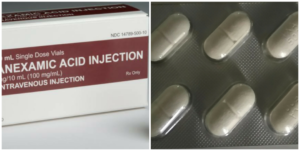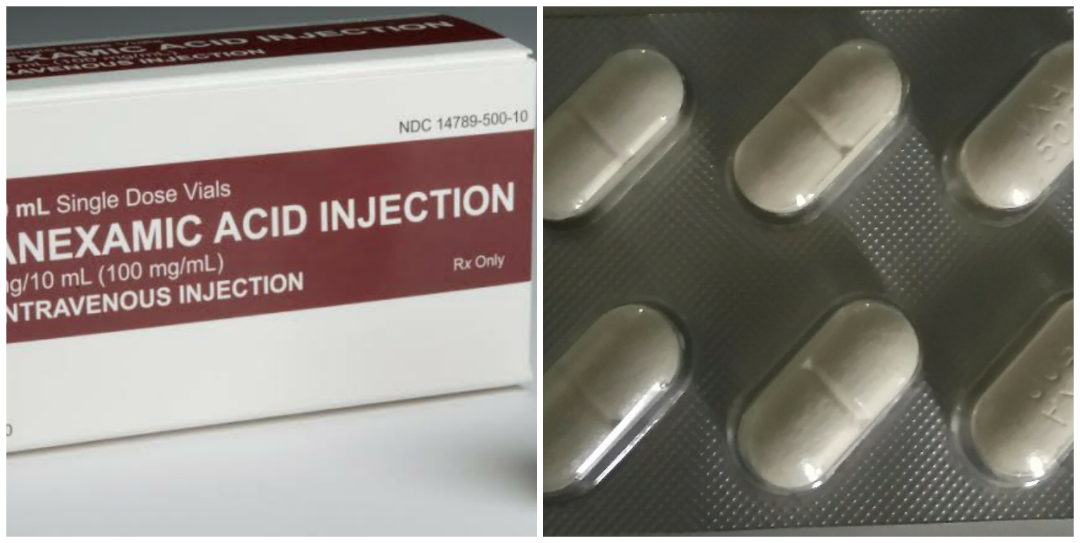Tranexamic Acid: Uses, Indications, Side Effects, Contraindications & Cost
CLINICAL PHARMACOLOGY AND MECHANISM OF ACTION:
Tranexamic acid is a antifibrinolytic agent and inhibits the activation of plasminogen activation, and at much higher concentrations, a noncompetitive inhibitor of plasmin, i.e., actions similar to aminocaproic acid.
It is about 10 times more potent in vitro than aminocaproic acid. It binds more strongly than aminocaproic acid to both the strong and weak receptor sites of the plasminogen molecule in a ratio corresponding to the difference in potency between the compounds.
Tranexamic-acid in a concentration of 1mg per ml does not aggregate platelets in vitro. Tranexamic-acid in concentrations as low as 1 mg per ml can prolong the thrombin time.
However, tranexamic-acid in concentrations up to 10 mg per ml in blood showed no influence on the platelet count, the coagulation time, or other coagulation factors in whole blood or citrated blood from normal subjects.
The plasma protein binding of tranexamic acid is about 3% at therapeutic plasma levels and seems to be fully accounted for by its binding to plasminogen. Tranexamic acid does not bind to serum albumin. After an intravenous does of 1g, the plasma concentration time curve shows at triexponential decay with a half-life of about 2 hours for the terminal elimination phase. The initial volume of distribution is about 9 to 12 liters.
Excretion
Urinary excretion is the main route of elimination via glomerular filtration. Overall renal clearance is equal to overall plasma clearance (110 to 116 ml/min), and more than 95% of the dose is excreted in the urine as unchanged drug.
Excretion of this drug is about 90% at 24 hours after intravenous administration of 10mg per kg body weight. An antifibrinolytic concentration of tranexamic remains in different tissues for about 17 hours, and in the serum, up to 8 hours.

DISTRIBUTION
Tranexamic-acid passes through the placenta. The concentration in cord blood after an intravenous injection of 10 mg per kg to pregnant women is about 30 mg per liter, as high as in the maternal blood.
It diffuses rapidly into joint fluid and the synovial membrane. In the joint fluid, the same concentration is obtained as in the serum. The biological half-life of tranexamic acid in the joint fluid is about 3 hours.
The concentration of tranexamic acid in a number of other tissues is lower than in blood. In breast milk, the concentration is about one hundredth of the serum peak concentration.
Its concentration in cerebrospinal fluid is about one tenth of that of the plasma. The drug passes the aqueous humor, the concentration being about one tenth of the plasma concentration.
It has been detected in semen where it inhibits fibrinolytic activity but does not influence sperm migration.
Route of administration
It is taken either by mouth (orally) or via injection into a vein.
INDICATIONS AND USAGE
Tranexamic acid injection prevent hemorrhage and reduce the need for replacement therapy during and following tooth extraction.
Other Uses of tranexamic acid
•Excessive blood loss from major trauma
•Excessive blood from post partum bleeding
•Excessive blood from nosebleeds
•Excessive blood from tooth extractions
•Heavy menstruation
•Excessive blood from surgery
CONTRAINDICATIONS:
Tranexamic acid injection is contraindicated:
➡️In patients with acquired defective color vision, since this prohibits measuring one endpoint that should be followed as a measure of toxicity.
➡️In patients with subarachnoid hemorrhage, anecdotal experience indicates that cerebral edema and cerebral infarction may be caused by tranexamic acid injection in such patients.
➡️In patients with active intravascular clotting.
➡️In patients with hypersensitivity to tranexamic acid or any of the ingredients.
SIDE EFFECTS
It is a relatively safe drug with minor reported side effects like:
Nausea
Vomiting
Headaches
Muscle pains
Diarrhoea
Bleeding problems (rare)
allergies (rare)
PRECAUTIONS:
General
💥The dose of tranexamic injection should be reduced in patients with renal insufficiency because of the risk of accumulation.
💥Ureteral obstruction due to clot formation in patients with upper urinary tract bleeding has been reported in patients treated with tranexamic acid injection.
💥Venous and arterial thrombosis or thromboembolism has been reported in patients treated with tranexamic acid injection.
💥In addition, cases of central retinal artery and central retinal vein obstruction have been reported.
💥Patients with a previous history of thromboembolic disease may be at increased risk for venous or arterial thrombosis.
💥The injection should not be administered concomitantly with Factor IX complex concentrates or anti-inhibitor coagulant concentrates, as the risk of thrombosis may be increased.
💥Patients with disseminated intravascular coagulation (DIC), who require treatment with the injection, must be under strict supervision of a physician experienced in treating this disorder.
💥Tranexamic injection may cause dizziness and therefore may influence the ability to drive or use machines.
DRUG INTERACTIONS:
No studies of interactions between tranexamic acid injection and other drugs have been conducted.
PREGNANCY (Category B):
Reproduction studies performed in mice, rats, and rabbits have not revealed any evidence of impaired fertility or adverse effects on the fetus due to tranexamic acid.
There are no adequate and well controlled studies in pregnant women. However, tranexamic -acid is known to pass the placenta and appears in cord blood at concentrations approximately equal to maternal concentration.
Because animal reproduction studies are not always predictive of human response, this drug should be used during pregnancy only if clearly needed.
NURSING MOTHERS AND BREASTFEEDING MOTHERS:
It is present in the mother’s milk at a concentration of about a hundredth of the corresponding serum levels. Caution should be exercised when tranexamic injection is administered to a nursing woman.
PEDIATRIC USE:
The drug has had limited use in pediatric patients, principally in connection with tooth extraction. The limited data suggest that dosing instructions for adults can be used for pediatric patients needed tranexamic injection therapy
GERIATRIC USE:
Clinical studies of tranexamic injection did not include sufficient numbers of subjects aged 65 and over to determine whether they respond differently from younger subjects.
Other reported clinical experience has not identified differences in responses between the elderly and younger patients.
In general, dose selection for an elderly patient should be cautious, usually starting at the low end of the dosing range, reflecting the greater frequency of decreased hepatic, renal or cardiac function, and of concomitant disease or other drug therapy.
This drug is known to be substantially excreted by the kidney, and the risk of toxic reactions to this drug may be greater in patients with impaired renal function. Because elderly patients are more likely to have decreased renal function, care should be taken in does selection, and it may be useful to monitor renal function.
DOSAGE AND ADMINISTRATION:
5-10ml by slow IV injection at a rate of 1ml per minute 2 to 3 times daily. For intravenous infusion, tranexamic acid injection may be mixed with most solutions for infusion such as electrolyte solutions, carbohydrate solutions, amino acid solutions, and dextran solutions.
The mixture should be prepared the same day the solution is to be used. Heparin may be added to tranexamic acid injection. Tranexamic acid injection should NOT be mixed with blood. The drug is a synthetic amino acid, and should NOT be mixed solutions containing penicillin.
PRESENTATION:
Tranexamic acid injection 500 mg/5ml, each 5ml labeled clear glass ampoule, such 5 ampoules kept in a tray and one tray packed in a unit carton with instruction for use.
COST OF TRANEXAMIC ACID
In Nigeria, the cost of a pack of injection tranexamic containing 5 ampoules is around #5,000 – #7,000 Naira. That is, the price of an ampoule of tranexamic acid is #1,000 Naira. For tranexamic tablets, a satchet containing 10 tablets cost about #1,500 Naira. A pack of tranexamic acid tablets cost about #5,000 Naira.
SHELF LIFE:
3 years from the date of manufacturing.
STORAGE:
Store below 30°C.
©NIMEDHEALTH
























